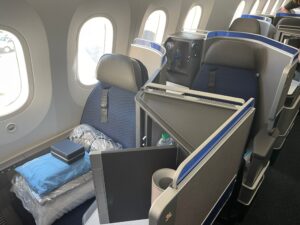Fewer domestic commercial flights were canceled in 2023 than at any point in at least the past decade, the Department of Transportation said this week.
Despite a few scattered rough patches over the course of the year, airline reliability surged following several bumpy years of coronavirus pandemic recovery in what the Transportation Security Administration said was the busiest-ever year for air travel.
Want more aviation news? Sign up for TPG’s free biweekly Aviation newsletter.
Of roughly 16.3 million scheduled flights throughout the country, fewer than 1.2% were canceled, the DOT said. The average cancellation rate since 2013 is 1.7%.
Holiday performance was especially successful, the DOT said, with 0.8% of flights canceled between Sunday, Dec. 17, and Monday, Jan. 1. That number was especially stark compared to the 2022 holidays, when a severe snowstorm and related operational meltdown at Southwest Airlines drove the cancellation rate to 8.2%.
“We’ve put more and more pressure on the airlines to prove the realism of their schedules, the level of staffing, anything else that could have led to controllable delays, and I think that work has really paid off,” Transportation Secretary Pete Buttigieg told TPG in a phone interview on Thursday.
“I think that reflects the response of the airlines to the pressure that we put on them,” he added, “as well as some work that we’ve been doing within the [DOT],” such as opening up new routings for aircraft to fly up and down the East Coast and working with the military to mitigate the impact of routine flight operations in Florida.
Buttigieg pointed to the record $140 million fine the DOT recently issued to Southwest for the 2022 episode, noting that the agency was “chang[ing] the economics that might create some reason for airlines to think that they would benefit from delaying important investments.”
Related: Southwest has a plan to get back on track after holiday meltdown. Here’s what execs tell TPG
The unrealistic scheduling practices Buttigieg referenced include planning flights that the airlines weren’t prepared to fully operate, he said, including “for reasons of gaining market share or other anti-competitive reasons.”
“We have active investigations right now, and are calling on airlines to do the right thing in the first place and not allow there to be reason for suspicion that they are knowingly scheduling flights that they’re not prepared to adequately serve,” he said.
The airlines also worked effectively to firm up their operations following the first post-pandemic years, Buttigieg said.
“When they were short on staffing, a number of airlines responded with better pay for these high-demand positions,” he said. Buttigieg cited higher pay rates for pilots at regional airlines as an example.
The low flight cancellation rates came even as the Federal Aviation Administration continued to cope with a shortage of air traffic controllers that has caused disruptions to U.S. flights over recent years.
While the agency successfully hired enough controllers — about 1,500 — to manage attrition from retirements and other departures last year, Buttigieg said the shortage remains ongoing, particularly in the busy airspace surrounding New York City and Jacksonville, Florida.
“There has been an ongoing challenge making sure there are enough qualified air traffic controllers available to work those areas,” which can contribute to delays, Buttigieg said.
“We’ve finally seen an increase in the number of total air traffic controllers,” he added. “I’m encouraged by that, but I’m also very concerned because we need to pick up the pace on that hiring to make sure it stays ahead of retirements and departures.”
The agency plans to hire 1,800 controllers this year, according to Buttigieg.
Buttigieg noted that a looming government shutdown would “completely stop hiring” by closing the agency’s training facilities.
“We need to be doing more, not less, when it comes to staffing and technology,” he said.
Last summer, the FAA instituted a slot waiver at airports in New York and Washington, D.C., to help manage the shortage — the policy encouraged airlines to fly up to 10% fewer flights from those airports, partly by combining frequencies on routes and using bigger aircraft, without risking losing market share. That waiver has since been extended through Oct. 27, 2024.
Buttigieg said that the DOT is continually reevaluating the waiver and that it had an “important effect” on helping to prevent cancellations and delays linked to congestion but suggested that it’s more of a temporary solution.
Related: The little-understood government rule that allows airlines to dominate certain airports
“We really want to make sure that the system as a whole is healthy and fluid, and we’re continuing to look at how all the different pieces come together, from ATC staffing to slot policy to the airlines’ own choices,” he said.
Part of that system includes congestion caused by private jets and general aviation aircraft.
Airlines for America, an industry group that represents the major U.S. airlines, among others, asked officials last week to help address the impact of private planes on the overall air traffic system, Reuters reported.
“I do think there’s a real concern around these private jets and how they compete for priority with passenger travel,” Buttigieg told TPG.
While priority should be given to commercial aircraft, Buttigieg said, improvements to the broader system, including air traffic control and airport infrastructure, will help widen capacity overall.



